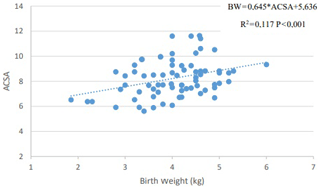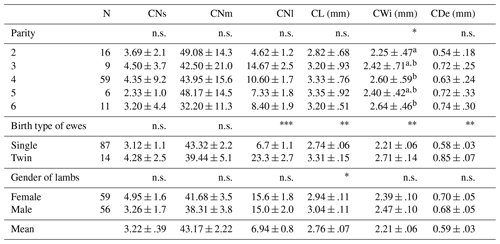Determination of relationships between placental characteristics and birth weight in Morkaraman sheep
The aim at this study was to determine the relationships among the
lamb birth weight, the average cotyledon surface area (ACSA) and cotyledon size.
Data were collected from 101 ewes. The general linear model and Pearson
correlation coefficient were used for statistical comparison and
determination of relationships between variables. Average birth weight (BW),
placental weight (PW), cotyledon number (CN), placental efficiency (PE),
cotyledon density (CD), cotyledon efficiency (CE) and ACSA were
4.175±.09, 448.8±13.4, 53.34±1.9, 9.65±.3,
0.125±.00, 10.66±.34 and 7.81±.19 cm2, respectively. There
was no difference between BW and PE for parity; however, PW, CN, CD, CE and
ACSA were affected (p<0.05) by parity. ACSA was found to be the
lowest (7.33±.99) with a parity of 2 and the highest (8.61±1.5)
with a parity of 4. Birth type affected significantly BW, CN, CD (p<0.05), PW (p<0.001) and ACSA (p<0.01). As the parity
progressed, cotyledon depth (CDe) (0.74±.30) and cotyledon width
(CWi) (2.64±.46) increased. ACSA, which is a new parameter for uterine
capacity, had positive correlations with BW (0.498; p<0.01), PW
(0.415; p<0.01), large cotyledon number (CNl) (0.685; p<0.01), cotyledon length (CL) (0.932; p<0.01), CWi (0.920; p<0.01) and
cotyledon depth (0.388; p<0.01). The most important finding of this
study was the positive correlation between the birth weight and the average
cotyledon surface area. This study indicates that average cotyledon surface
area and cotyledon size traits (CL and CWi) may be more effective parameters
to produce heavier lambs. In conclusion, it is thought that lamb deaths will
decrease as a result of triggering placental development with proper feeding
during pregnancy. For this purpose, it is recommended to conduct new studies
examining the relationship between pregnancy feeding and ACSA.
Highlights.
-
Cotyledon number and cotyledon density decrease with parity, while CE increases.
-
The birth type has a significant effect on BW, PW, CN and CD.
-
There are positive correlations between the placental weight and large cotyledon number, cotyledon length and cotyledon width.
-
ACSA can be used as an important parameter to increase the weight of lambs.
-
Especially in multiple birthing, ACSA has been found to be a more determinant index to express uterine capacity instead of PE or CE.









